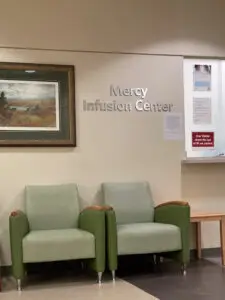Okay, so I couldn’t wait all that long to review the my pathology report. I sat down and started to go through it the next day. Even with my medical knowledge I needed to look up the vast majority of words within that report. There was a lot of information contained in that report and it took me quite a while to get through it.
My Pathology Report Answered Questions I Had For Years
What did I learn? Throughout my adult life I’ve had a variety of issues in my gut. Nothing actually diagnosed, just odd and end pains and discomfort. I never thought much of it since it came and went without any real issue. But now with this report in my hand I began to understand better some of the issues.
I had already known about a cyst on my left ovary. We were friends. I told it that it could remain as long as it didn’t cause any real grief. It had been there easily for more than a couple decades. Pathology confirmed that it was a benign cyst.
Endosalpingosis
It turns out I have had something called endosalpingosis. Never having heard of it before, I spent some time looking it up. Turns out it is similar to endometriosis except the tissue does not arise from the endometrium as it would with endometriosis but rather from the fallopian tubes. It creates adhesions throughout the gut which would explain what was found during surgery. The pathology report makes mention many times of the adhesions found within the tissue sample.
A few years ago I was going on a photographic trip to Utah. I was living in Tucson at the time so it was something like a nine hour drive. When we left I was feeling nauseous with some pain in my tummy. I didn’t think too much of it and assumed it would get better. By the time we were about 2/3 of the way to Utah I could no longer drive and started to vomit every few miles. Once we got up to our destination I was off to the emergency room since things just kept getting worse and worse. Turns out I had a complete blockage of my small intestine. Surgery revealed the best case scenario – adhesions! Now I understood those adhesions were most likely caused by the endosalpingosis the pathology revealed.
My Doc Removed 22 Lymph Nodes
I had asked my surgeon to remove as few lymph nodes as possible during surgery. I ended up telling him I’d defer to his judgement. The pathology report revealed he ended up taking a whopping 22 lymph nodes! I was not happy. Not even close to what I had in mind! There were nodes taken from my pelvic area including the sentinel nodes and others taken from around the aorta. Some were a bit larger than others; some were encased in the tissue from the endosalpingosis. But none of them were malignant!
Dedifferentiated Endometrial Cancer Joined The Party
There was something in the report that I initially skimmed over not realizing its importance at the time. While the report indicated I remained with a grade 1 endometroid adenocarcinoma, there was also mention of dedifferentiated endometrial carcinoma. I tried to ignore what became a strong, nagging doubt that my grade 1 diagnosis was going to hold. But I also didn’t understand at the time that I actually had two cancers, both the endometroid and dedifferentiated.
Another bit of good news was that I was now staged at 1a which meant the cancer didn’t go very deep into the endometrium. It is the best staging I could have expected.
There were so many other things on the report that I didn’t understand. Some things I tested positive or negative for but didn’t know if that was a good or bad thing!
Lymphovascular Invasion
There was something called lymphovascular invasion (LVI) that was identified. What is that? It is defined as cancer found within the blood or lymph vessels. I’m thinking that doesn’t sound good and I guess that’s true since it is an indicator of potential for metastasis or recurrence. I’ve come to think of it as the method cancer uses to leave the original site and go off to other places it land.
Ultimately it was determined I didn’t have Lynch syndrome, a hereditary syndrome predisposing one to cancer of the female organs, colorectal and other cancers. This was good news since that meant none of my family would be susceptible to those cancers, at least not through my genetics.
Wait, Is It Actually a Grade 3?
While I was able to figure out a whole lot of the report myself, the part that was still confusing to me was my overall cancer diagnosis and its grade. By the time I got to my post surgical appointment I pretty much knew I would be graded at a 3 but didn’t really grasp the rest of it.
My doctor explained to me that it was like having two different cancers within my endometrium. Looking at the pathology report I can begin to see how different they are. For instance, while the endometroid part responded to female hormones, the dedifferentiated did not. There were other results that indicated similar differences between the two. Yes, I had two different endometrial cancers. Unfortunately the grade was changed from 1 to 3. My easy peasy cancer suddenly became a potential killer.
Staged at 1a
Since my stage was only 1a my doctor didn’t seem terribly concerned about the other issues. Yes, I had extensive LVI but without lymph node involvement and with the clean pelvic washings there was no indication that the cancer had actually spread anywhere. He was quick to point out that he was quite happy that he took out those 22 lymph nodes since that allowed him to feel more comfortable knowing that the cancer hadn’t spread to any of those lymph nodes. I begrudgingly understood his point. Guess his instincts paid off.
Recommended Treatment
My doctor recommended further treatments since we were dealing with a highly aggressive cancer even though there were no signs of cancer left after the hysterectomy. There was no way of knowing if cancer cells were just around the corner waiting to do their thing. As a result, both chemotherapy and radiation were recommended.
Reluctantly, I agreed to start chemotherapy – six rounds of Carboplatin and Paclitaxel (Taxol), the typical frontline chemotherapy drugs for endometrial cancer. We also discussed my desire to get a port placed into my chest for easier access while giving me chemo. For everything I read, this seemed like a no brainer. It was one of the easier decisions I’ve had to make on this journey.
Armed with my new, full diagnosis I now felt a bit overwhelmed. I do not remember being particularly frightened although with that diagnosis you’d think I would be. Perhaps the biggest surprise was my choice to go ahead with chemotherapy. That was definitely a unexpected surprise to me!




